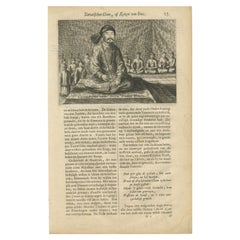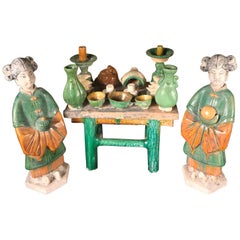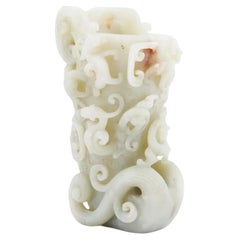Ancient Chinese Antique
Antique 17th Century Prints
Paper
Recent Sales
Antique 16th Century Chinese Ming Sculptures and Carvings
Ceramic, Pottery
Early 20th Century Chinese Vases
Jade
Antique 18th Century Chinese Metalwork
Bronze
1990s Old Masters Figurative Sculptures
Bronze
Antique 15th Century and Earlier Chinese Antiquities
Bronze
Antique 15th Century and Earlier Chinese Other Antiquities
Pottery
Antique 15th Century and Earlier Chinese Other Vases
Pottery
Antique 15th Century and Earlier Chinese Ming Sculptures and Carvings
Iron
Antique Late 19th Century Asian Sculptures and Carvings
Soapstone
Antique Early 1900s Chinese Chinoiserie Ceramics
Ceramic
Antique 16th Century Chinese Ming Sculptures and Carvings
Ceramic, Pottery
Antique 15th Century and Earlier Chinese Antiquities
Bronze
Antique 15th Century and Earlier Chinese Arts and Crafts Ceramics
Pottery
Antique Late 18th Century Japanese Edo Paintings and Screens
Paper
Antique 15th Century and Earlier Chinese Other Ceramics
Pottery
Antique 15th Century and Earlier Chinese Other Ceramics
Pottery
Antique 18th Century and Earlier Chinese Sculptures
Antique 15th Century and Earlier Chinese Other Ceramics
Pottery
20th Century American Charm Bracelets
Cultured Pearl, 18k Gold
People Also Browsed
Antique 1780s Prints
Paper
Ancient Chinese Antique For Sale on 1stDibs
How Much is a Ancient Chinese Antique?
- 1stDibs ExpertApril 5, 2022In ancient China, pottery was primarily used for cooking, storing and serving food. Throughout the Han Dynasty, the art of pottery evolved to include ceramic figures, the best example of this being the TerraCotta Warriors who guard the tomb of Emperor Qin Shi Huang. Find a variety of antique Chinese pottery from many different eras on 1stDibs.
- 1stDibs ExpertNovember 4, 2024To identify antique Chinese furniture, look carefully at its details. Chinese craftsmen often built furniture using mortise and tenon joinery, eliminating the need for nails and screws. If you see this type of hardware, your piece is likely not at least 100 years old, especially if the hardware still looks new and shiny. Since antique furniture was handmade, you will normally see slight imperfections, such as tool marks or slight variations in carvings. Pieces that appear completely uniform and pristine are less often genuine antiques.
When present, maker's marks can also be helpful. Research the marks to learn more about when the maker was active and producing pieces like yours. Alternatively, you can have a certified appraiser or experienced antique dealer evaluate your furniture for you.
Shop an assortment of antique Chinese furniture.  PAGODA REDOctober 7, 2020
PAGODA REDOctober 7, 2020To determine the age of a Chinese furniture piece, look carefully at the joinery and finish. Natural expansion and contraction of the wood over time will cause a joint to protrude or retract, distorting a once-seamless fit. Antique lacquer finishes become crackled and worn over time. Areas of exposed wood, such as the underside of a table, the footrest of a chair, or the back of a cabinet should appear raw and dry compared to the finished surface. With use, the legs of tables and chairs become weathered near the bottom from precipitation and use.
 Lotus GallerySeptember 23, 2020
Lotus GallerySeptember 23, 2020The best way to know is to take it to an expert, such as an appraiser, reputable dealer or auction house, or museum
Read More
Symbols of Happiness and Rebirth Adorn This Japanese Satsuma Bowl
Decorated with white cranes and the sought-after thousand-butterflies motif, the Meiji-period vessel offers both a celebration of traditional aesthetics and a clear reflection of the era’s appetite for exquisite export pieces.
Chicago’s Pagoda Red Has a Spirited Mix of Asian Antiques and Bold New Art
For 25 years, gallerist Betsy Nathan has leveraged her keen eye and key connections to bring a unique selection of rare finds to the market.
In L.A., Gallerist JF Chen Has Long Championed Eclectic Blue-Chip Design
Now working alongside his daughter Bianca, dealer Joel Chen has presented a most covetable array of antiques, art and contemporary creations for more than 40 years.
12 Calming Spaces Inspired by Japanese Design
From cherry-blossom-adorned walls paired with glamorous lighting to wood-paneled ceilings above checkerboard-patterned chairs, these 12 spaces seamlessly blend Eastern and Western aesthetics.
Rodrigo Rivero Lake’s Mexico City Showroom Is a Museum-Worthy Trove of Spanish Colonial and Asian Antiques
The dealer and curator has spent the past 50 years amassing a collection of exceptional art, furniture and architectural elements that trace the cultural influence of the Spanish empire from Europe to the Americas and beyond.
16 Refined Asian-Inspired Interiors
These spaces exemplify how Eastern elements elevate a home's decor.


